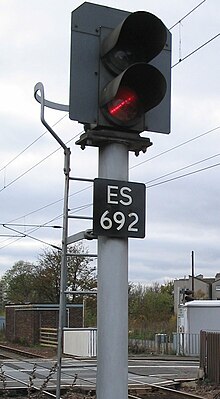This article needs additional citations for verification. (September 2023) |

The railway signalling system used across the majority of the United Kingdom rail network uses lineside signals to control the movement and speed of trains.
The modern-day system mostly uses two, three, and four aspect colour-light signals using track circuit – or axle counter – block signalling.[1][2] It is a development of the original absolute block signalling that is still being used on many secondary lines. The use of lineside signals in Britain is restricted to railways with a maximum speed limit of up to 125 miles per hour (201 km/h). This is the maximum speed at which the train can travel safely using line-side signalling; if the train runs any faster, it will not be possible for the train driver to safely read colour-light signalling. Trains operating at speeds faster than 125 mph (for example on High Speed 1) use an in-cab signalling system that automatically determines and calculates speed restrictions.
- ^ "Track circuit block regulations". RSSB. Retrieved 2 September 2023.
- ^ "Railsigns.uk - Track Circuit Block". Retrieved 7 March 2017.
